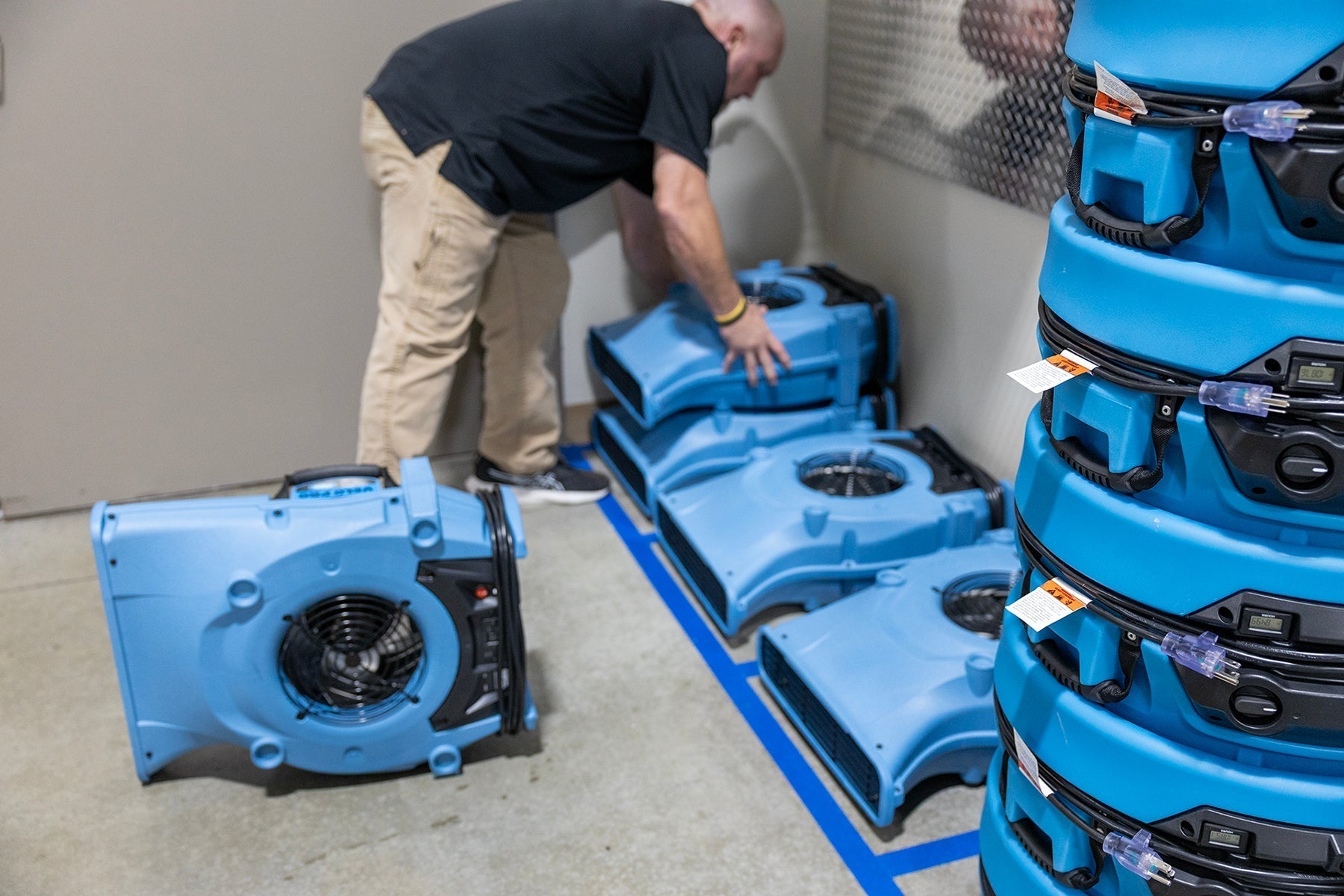By TJ Grim, Ready 2 Respond Trainer
Effective water damage response depends on more than just having enough drying equipment, as not all equipment models – or setups – are created equal. Even well-intentioned teams fall into a common trap: choosing individual units based on price and availability without fully considering how all the pieces will work together as a system.
This piecemeal approach can lead to inconsistent, unpredictable results in emergency situations, when every minute matters. Just as HVAC components are engineered to work as a complete system – and performance suffers when pieces are cobbled together – drying equipment performs best when carefully selected and deployed as a cohesive system.
With a few smart strategies, facilities teams can transform a fragmented setup into a true drying system that delivers faster, more thorough results.
1. Simplify Training with a Unified System
At first glance, many dehumidifiers provide similar water removal and all airmovers blow air, so why does it matter which brand you buy? There is a real difference, and it isn’t just in the performance of individual units; it’s also about how they work together as a system. In a unified system of equipment designed to be used together, airflow patterns, moisture-removal rates, and filtration performance complement one another to create a more effective drying environment.
There’s also a significant benefit for facilities teams in standardizing to a single, cohesive system – it streamlines training and builds confidence – and reinforces developing standard operating procedures (SOPs). Technicians learn equipment setup strategies that they can apply consistently across water incidents. They don’t have to switch between different types of controls, operations, and performance profiles depending on which unit is available at the time. Equipment familiarity pays off under pressure – it means faster setup, fewer errors, and a more coordinated response.
2. Invest in Professional-Grade Equipment
Even the best system falls short if the equipment itself isn’t performing. Professional-grade drying equipment is built for speed, reliability, and efficiency.
Compared to lower-cost consumer options (or “making do” with box fans and shop vacs), professional drying equipment is engineered to:
- Move more air with precision and control
- Much quieter operation, minimizing disruptions in occupied areas
- Withstand the wear and tear of heavy use and being moved around frequently in demanding conditions
- Maintain reliable performance for extended periods of time – throughout the full drying cycle
- Be easily serviceable with repair parts readily available, if problems arise.
3. Trust Tested Specs
Many dehumidifiers make performance claims that sound impressive – but those numbers don’t always hold up in real conditions. For example, some units labeled “LGR” (low grain refrigerant) may not remove any moisture at low humidity levels – exactly when performance matters most to ensure thorough drying.
That’s why tested performance is so important. Professional-grade dehumidifiers are tested under controlled, low-humidity conditions to ensure they can continue pulling moisture effectively from deep within building materials, not just in the early hours of a drying project. This kind of testing gives facilities teams a more reliable picture of what a unit can do on the job, not just based on hypothetical performance.
The most reliable equipment manufacturers report accurate, tested product specs to ensure that they reflect actual performance rather than marketing claims.
4. Prioritize Certified Safety
Safety is always the top priority for facilities teams. Professional drying equipment is third-party tested and certified to meet rigorous UL standards, giving teams peace of mind.
Certified equipment:
- Reduces the risk of electrical and mechanical failures
- Meets insurance and compliance requirements
- Protects both staff and building occupants
Cutting corners on certifications can save money up front but create far greater risks.
5. Train for Consistency and Speed
Even the best equipment won’t perform at its peak without a well-trained team behind it. Standardized equipment training helps team members deploy, operate, monitor, and adjust equipment quickly and correctly – even in high-pressure situations. When everyone knows how the system works, response time improves, errors decrease, and drying results are more consistent.
Hands-on, simulation-based training such as that offered through the Ready 2 Respond® Program immerses facilities teams in realistic scenarios that build the kind of speed, confidence, and consistency that only comes from real-world experience.
6. Unified and Ready
When every minute matters, having the right drying strategy and unified equipment systems in place makes all the difference. By taking a systemized approach to performance, safety, and training, facilities teams can respond faster, minimize disruption, and reduce costs.
Contact the R2R team for help in strengthening water damage response strategies and building more effective drying systems. For facility management tips, follow us on LinkedIn and subscribe to our Facility Insights newsletter.


Keep Building Occupants Informed During Water Damage Response
Water Damage in Multi-Family Buildings: What Every Property Team Should Know